Organisational Behaviour: A Self-Assessment Report on Leadership
VerifiedAdded on 2023/06/05
|12
|2827
|97
Report
AI Summary
This report presents a self-assessment of leadership skills and characteristics using various personality tests, including MBTI, Big 5 Personality Test, McClelland Need Analysis, and the Thomas-Kilman conflict mode instrument. The assessment identifies key strengths and weaknesses, highlighting the author's potential as a future leader. The report includes a critical analysis of the test results, reflecting on the author's leadership style and providing an action plan for further development. The author identifies as an ENFJ on the MBTI test and demonstrates high agreeableness and conscientiousness. The report concludes with a plan to improve negotiation skills and delegate responsibilities effectively. Desklib provides similar resources and study tools for students.
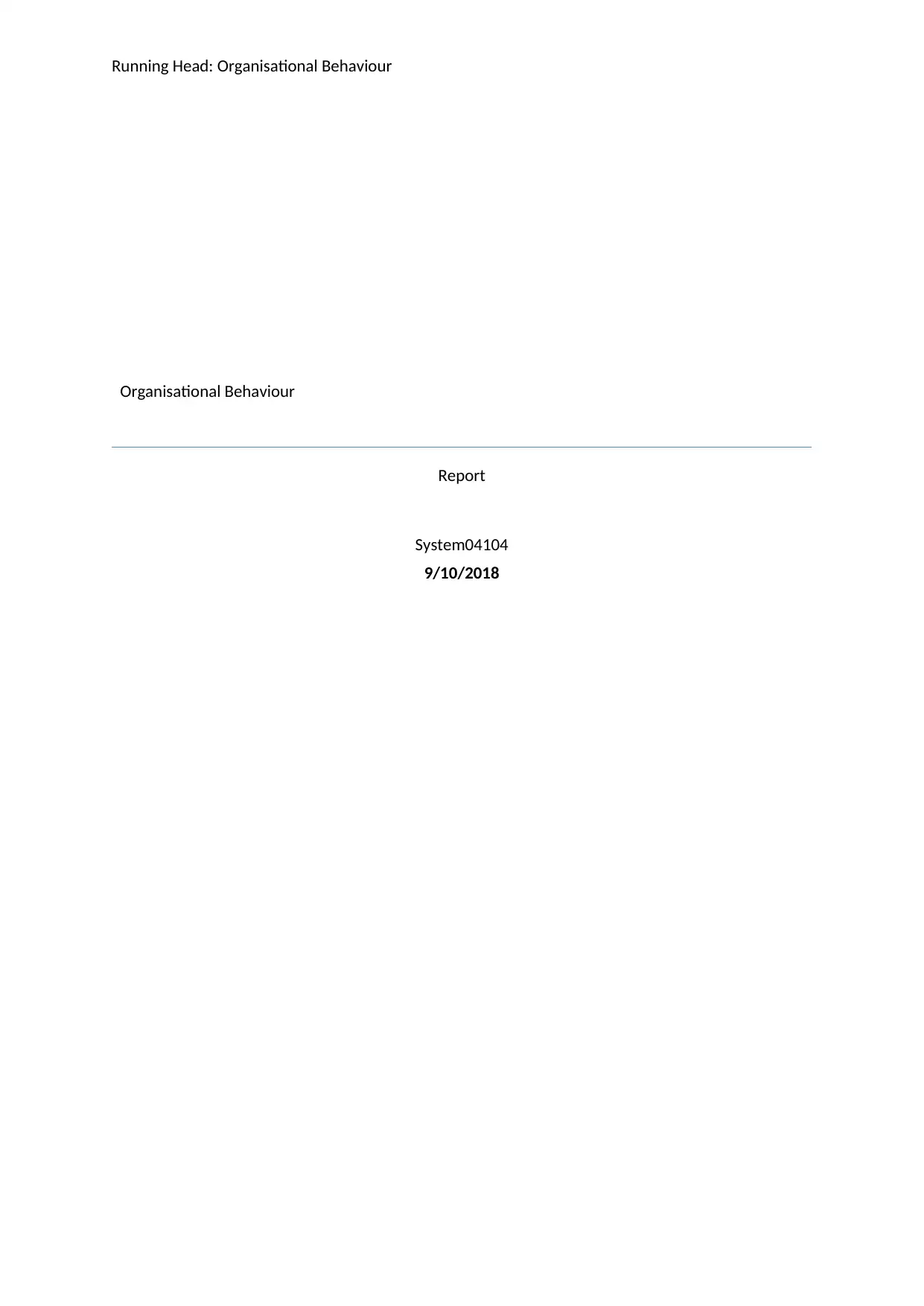
Running Head: Organisational Behaviour
Organisational Behaviour
Report
System04104
9/10/2018
Organisational Behaviour
Report
System04104
9/10/2018
Paraphrase This Document
Need a fresh take? Get an instant paraphrase of this document with our AI Paraphraser
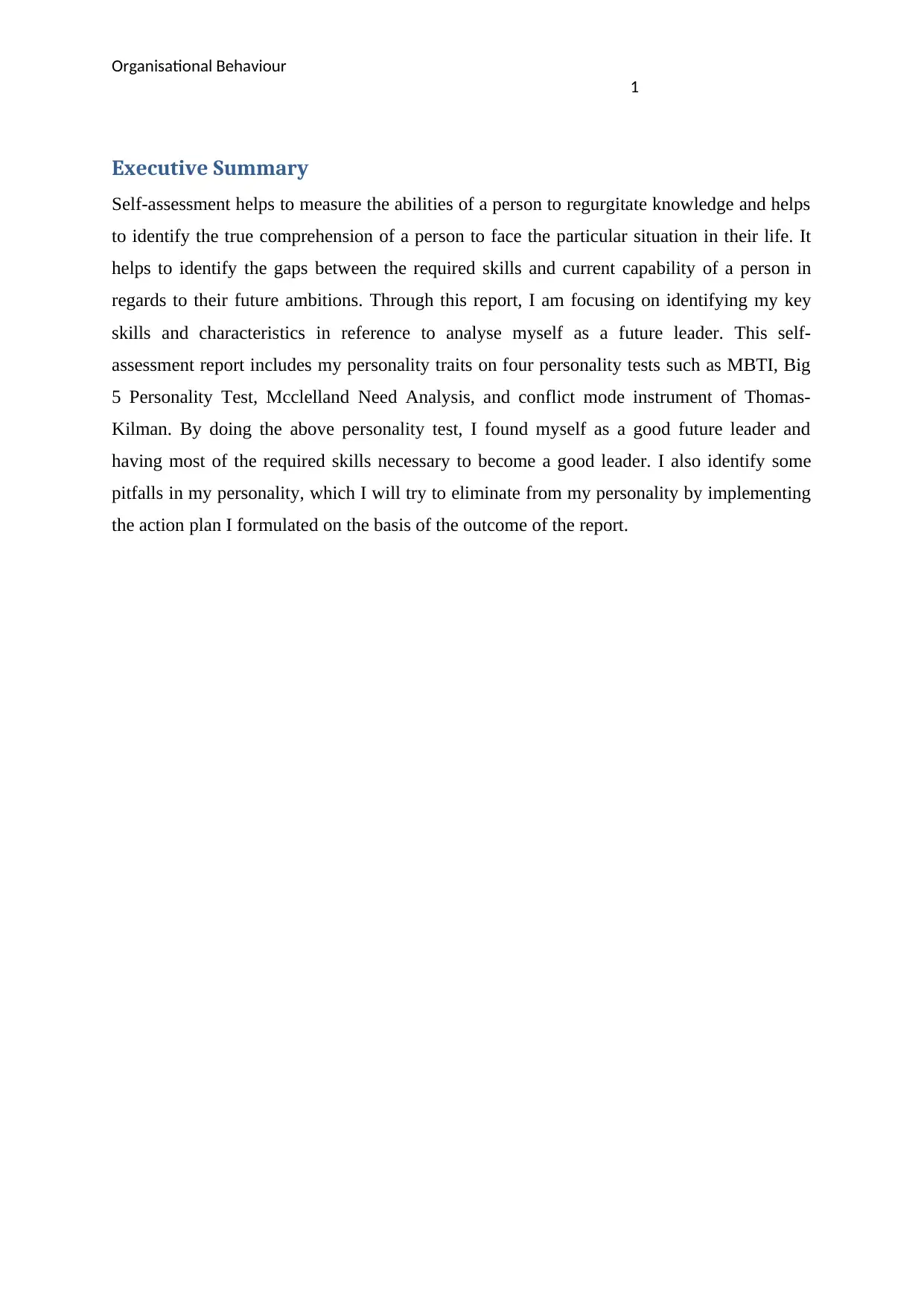
Organisational Behaviour
1
Executive Summary
Self-assessment helps to measure the abilities of a person to regurgitate knowledge and helps
to identify the true comprehension of a person to face the particular situation in their life. It
helps to identify the gaps between the required skills and current capability of a person in
regards to their future ambitions. Through this report, I am focusing on identifying my key
skills and characteristics in reference to analyse myself as a future leader. This self-
assessment report includes my personality traits on four personality tests such as MBTI, Big
5 Personality Test, Mcclelland Need Analysis, and conflict mode instrument of Thomas-
Kilman. By doing the above personality test, I found myself as a good future leader and
having most of the required skills necessary to become a good leader. I also identify some
pitfalls in my personality, which I will try to eliminate from my personality by implementing
the action plan I formulated on the basis of the outcome of the report.
1
Executive Summary
Self-assessment helps to measure the abilities of a person to regurgitate knowledge and helps
to identify the true comprehension of a person to face the particular situation in their life. It
helps to identify the gaps between the required skills and current capability of a person in
regards to their future ambitions. Through this report, I am focusing on identifying my key
skills and characteristics in reference to analyse myself as a future leader. This self-
assessment report includes my personality traits on four personality tests such as MBTI, Big
5 Personality Test, Mcclelland Need Analysis, and conflict mode instrument of Thomas-
Kilman. By doing the above personality test, I found myself as a good future leader and
having most of the required skills necessary to become a good leader. I also identify some
pitfalls in my personality, which I will try to eliminate from my personality by implementing
the action plan I formulated on the basis of the outcome of the report.
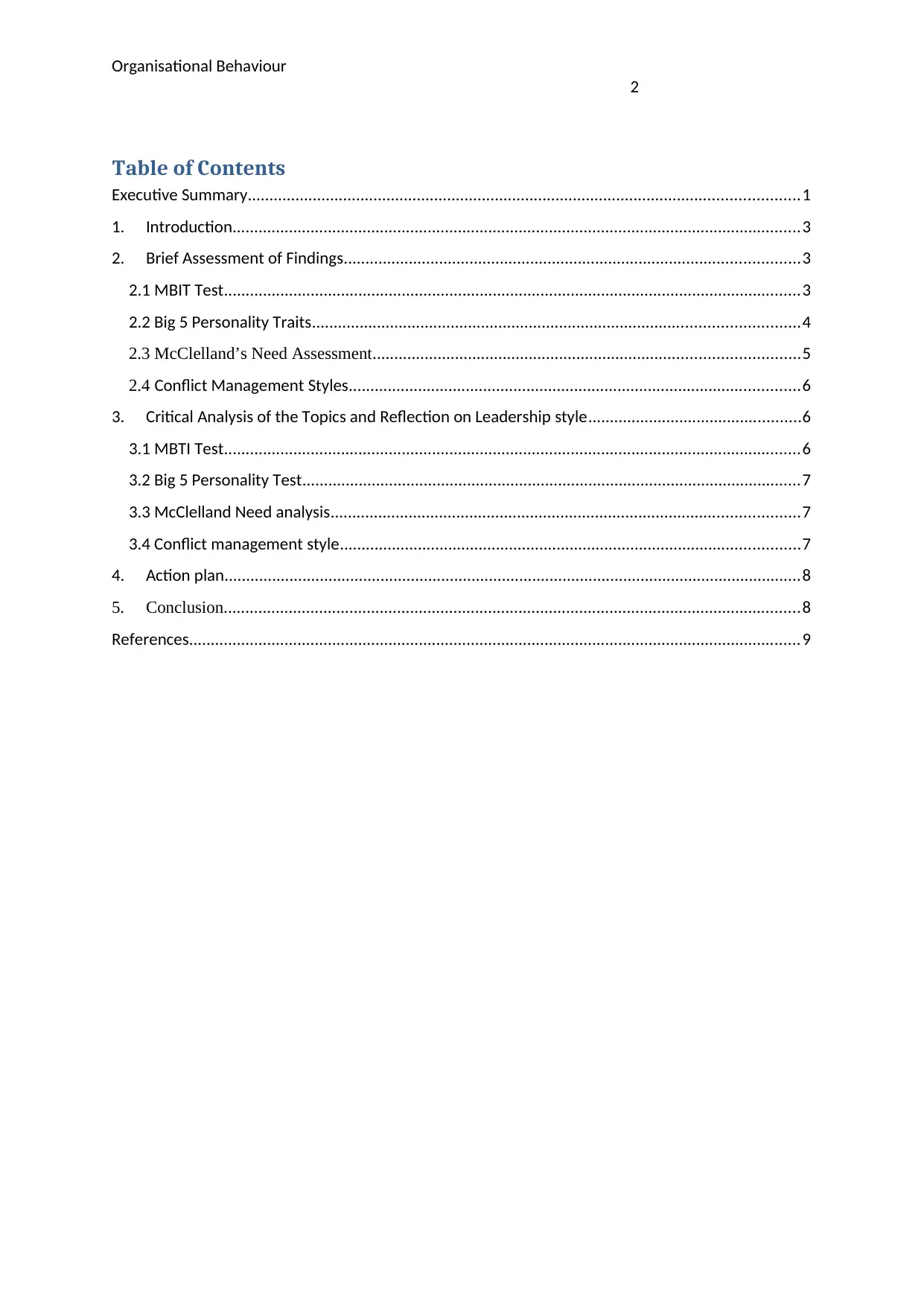
Organisational Behaviour
2
Table of Contents
Executive Summary...............................................................................................................................1
1. Introduction...................................................................................................................................3
2. Brief Assessment of Findings.........................................................................................................3
2.1 MBIT Test.....................................................................................................................................3
2.2 Big 5 Personality Traits................................................................................................................4
2.3 McClelland’s Need Assessment..................................................................................................5
2.4 Conflict Management Styles........................................................................................................6
3. Critical Analysis of the Topics and Reflection on Leadership style.................................................6
3.1 MBTI Test.....................................................................................................................................6
3.2 Big 5 Personality Test...................................................................................................................7
3.3 McClelland Need analysis............................................................................................................7
3.4 Conflict management style..........................................................................................................7
4. Action plan.....................................................................................................................................8
5. Conclusion.....................................................................................................................................8
References.............................................................................................................................................9
2
Table of Contents
Executive Summary...............................................................................................................................1
1. Introduction...................................................................................................................................3
2. Brief Assessment of Findings.........................................................................................................3
2.1 MBIT Test.....................................................................................................................................3
2.2 Big 5 Personality Traits................................................................................................................4
2.3 McClelland’s Need Assessment..................................................................................................5
2.4 Conflict Management Styles........................................................................................................6
3. Critical Analysis of the Topics and Reflection on Leadership style.................................................6
3.1 MBTI Test.....................................................................................................................................6
3.2 Big 5 Personality Test...................................................................................................................7
3.3 McClelland Need analysis............................................................................................................7
3.4 Conflict management style..........................................................................................................7
4. Action plan.....................................................................................................................................8
5. Conclusion.....................................................................................................................................8
References.............................................................................................................................................9
⊘ This is a preview!⊘
Do you want full access?
Subscribe today to unlock all pages.

Trusted by 1+ million students worldwide
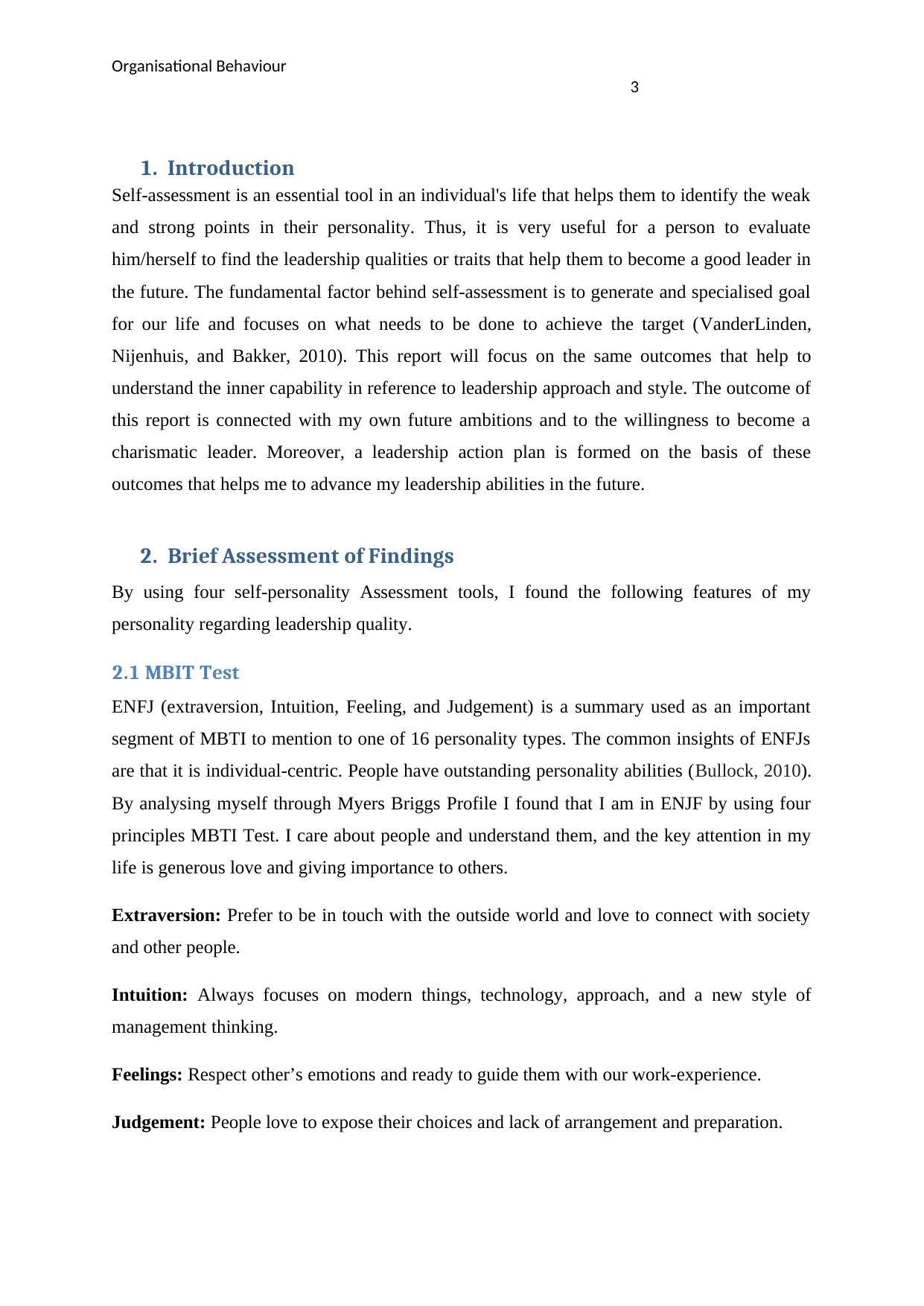
Organisational Behaviour
3
1. Introduction
Self-assessment is an essential tool in an individual's life that helps them to identify the weak
and strong points in their personality. Thus, it is very useful for a person to evaluate
him/herself to find the leadership qualities or traits that help them to become a good leader in
the future. The fundamental factor behind self-assessment is to generate and specialised goal
for our life and focuses on what needs to be done to achieve the target (VanderLinden,
Nijenhuis, and Bakker, 2010). This report will focus on the same outcomes that help to
understand the inner capability in reference to leadership approach and style. The outcome of
this report is connected with my own future ambitions and to the willingness to become a
charismatic leader. Moreover, a leadership action plan is formed on the basis of these
outcomes that helps me to advance my leadership abilities in the future.
2. Brief Assessment of Findings
By using four self-personality Assessment tools, I found the following features of my
personality regarding leadership quality.
2.1 MBIT Test
ENFJ (extraversion, Intuition, Feeling, and Judgement) is a summary used as an important
segment of MBTI to mention to one of 16 personality types. The common insights of ENFJs
are that it is individual-centric. People have outstanding personality abilities (Bullock, 2010).
By analysing myself through Myers Briggs Profile I found that I am in ENJF by using four
principles MBTI Test. I care about people and understand them, and the key attention in my
life is generous love and giving importance to others.
Extraversion: Prefer to be in touch with the outside world and love to connect with society
and other people.
Intuition: Always focuses on modern things, technology, approach, and a new style of
management thinking.
Feelings: Respect other’s emotions and ready to guide them with our work-experience.
Judgement: People love to expose their choices and lack of arrangement and preparation.
3
1. Introduction
Self-assessment is an essential tool in an individual's life that helps them to identify the weak
and strong points in their personality. Thus, it is very useful for a person to evaluate
him/herself to find the leadership qualities or traits that help them to become a good leader in
the future. The fundamental factor behind self-assessment is to generate and specialised goal
for our life and focuses on what needs to be done to achieve the target (VanderLinden,
Nijenhuis, and Bakker, 2010). This report will focus on the same outcomes that help to
understand the inner capability in reference to leadership approach and style. The outcome of
this report is connected with my own future ambitions and to the willingness to become a
charismatic leader. Moreover, a leadership action plan is formed on the basis of these
outcomes that helps me to advance my leadership abilities in the future.
2. Brief Assessment of Findings
By using four self-personality Assessment tools, I found the following features of my
personality regarding leadership quality.
2.1 MBIT Test
ENFJ (extraversion, Intuition, Feeling, and Judgement) is a summary used as an important
segment of MBTI to mention to one of 16 personality types. The common insights of ENFJs
are that it is individual-centric. People have outstanding personality abilities (Bullock, 2010).
By analysing myself through Myers Briggs Profile I found that I am in ENJF by using four
principles MBTI Test. I care about people and understand them, and the key attention in my
life is generous love and giving importance to others.
Extraversion: Prefer to be in touch with the outside world and love to connect with society
and other people.
Intuition: Always focuses on modern things, technology, approach, and a new style of
management thinking.
Feelings: Respect other’s emotions and ready to guide them with our work-experience.
Judgement: People love to expose their choices and lack of arrangement and preparation.
Paraphrase This Document
Need a fresh take? Get an instant paraphrase of this document with our AI Paraphraser

Organisational Behaviour
4
2.2 Big 5 Personality Traits
The Big 5 Personality Test check the personality of a person on following five magnitudes of
character; Openness, Conscientiousness, Extraversion, Agreeableness and Neuroticism.
The Big 5 Factor Describing a low
range scoring
person
Score %
score
Range Describing a
high range
scoring person
Extraversion introvert 8 53 moderate extrovert
Agreeableness Prefer having your
say or way of issues
13 86 High Value Harmony
Conscientiousness Easily distracted,
pursue many goals,
and more hedonistic
14 93 High Fever goals in a
purposeful way
Emotional Stability Negative emotional
stability
10 66 moderate Positive
emotional
stability
Openness to
experience
More conventional
and find comfort in
the familiar
11 73 moderate Novelty,
innovation, and
interests
My score just above average in extraversion (53%) which means I am not talkative neither I
introvert; rather I used to speak where necessary. It also shows that I am energetic and like to
get inspiration from the external world, which is connected to the courtesy of other
individuals.
I score 86% in agreeableness, which means it indicates that I have the high level of
compassion and I am always trying to help others in their problems. I believe that they should
learn how to handle problems, which show that this type of person regulates the propensity of
an individual to put their own interests and requirements below to the interest of others
(Ozga, 2009).
My score at this time is too high (93%) in conscientiousness, which I consider that I am well
organised and not easily distracted from my goals that is true about me. This personality
4
2.2 Big 5 Personality Traits
The Big 5 Personality Test check the personality of a person on following five magnitudes of
character; Openness, Conscientiousness, Extraversion, Agreeableness and Neuroticism.
The Big 5 Factor Describing a low
range scoring
person
Score %
score
Range Describing a
high range
scoring person
Extraversion introvert 8 53 moderate extrovert
Agreeableness Prefer having your
say or way of issues
13 86 High Value Harmony
Conscientiousness Easily distracted,
pursue many goals,
and more hedonistic
14 93 High Fever goals in a
purposeful way
Emotional Stability Negative emotional
stability
10 66 moderate Positive
emotional
stability
Openness to
experience
More conventional
and find comfort in
the familiar
11 73 moderate Novelty,
innovation, and
interests
My score just above average in extraversion (53%) which means I am not talkative neither I
introvert; rather I used to speak where necessary. It also shows that I am energetic and like to
get inspiration from the external world, which is connected to the courtesy of other
individuals.
I score 86% in agreeableness, which means it indicates that I have the high level of
compassion and I am always trying to help others in their problems. I believe that they should
learn how to handle problems, which show that this type of person regulates the propensity of
an individual to put their own interests and requirements below to the interest of others
(Ozga, 2009).
My score at this time is too high (93%) in conscientiousness, which I consider that I am well
organised and not easily distracted from my goals that is true about me. This personality

Organisational Behaviour
5
attribute of conscientiousness describes the capability of the individual focused on their
targets and not divert in many ways (Barlett and Anderson, 2012). I found myself in a
situation where I always found a purpose behind any work and not distracted easily.
I score moderate in Emotional stability (66%) which is a moderate score, it means I am a
positive person and understand others but also not easily getting affected by other's negative
thoughts and opinions. This character shows the human nature towards the emotions like
distress, sorrow, feelings, love, nervousness etc.
The medium score in Openness (73%) indicates that I am not very much imaginative or
exploratory rather, I am average in imaginative and exploratory. I feel that I am satisfied with
what is going on in my current life and sometimes I found information about the nature of the
problem with unique ideas. A medium score in openness is the replication of my average
curiosity in sculpture and philosophy.
2.3 McClelland’s Need Assessment
The outcome founded on the fifteen questions experiment and their marks are acknowledged
in Achievement, Power, and Affiliation in the following manner.
Achievement Power Affiliation
5 5 3
4 4 4
5 3 5
4 3 3
5 4 3
23 19 18
The outcome of the McClelland’s Need Assessment test is that I have great need of
achievement and achievement and appreciation two major motivators, which energize me in
the group as a leader and also will be helpful in workplace to dealing with people and these
motivators display my goal desire focus (Pines, et.al, 2012).
5
attribute of conscientiousness describes the capability of the individual focused on their
targets and not divert in many ways (Barlett and Anderson, 2012). I found myself in a
situation where I always found a purpose behind any work and not distracted easily.
I score moderate in Emotional stability (66%) which is a moderate score, it means I am a
positive person and understand others but also not easily getting affected by other's negative
thoughts and opinions. This character shows the human nature towards the emotions like
distress, sorrow, feelings, love, nervousness etc.
The medium score in Openness (73%) indicates that I am not very much imaginative or
exploratory rather, I am average in imaginative and exploratory. I feel that I am satisfied with
what is going on in my current life and sometimes I found information about the nature of the
problem with unique ideas. A medium score in openness is the replication of my average
curiosity in sculpture and philosophy.
2.3 McClelland’s Need Assessment
The outcome founded on the fifteen questions experiment and their marks are acknowledged
in Achievement, Power, and Affiliation in the following manner.
Achievement Power Affiliation
5 5 3
4 4 4
5 3 5
4 3 3
5 4 3
23 19 18
The outcome of the McClelland’s Need Assessment test is that I have great need of
achievement and achievement and appreciation two major motivators, which energize me in
the group as a leader and also will be helpful in workplace to dealing with people and these
motivators display my goal desire focus (Pines, et.al, 2012).
⊘ This is a preview!⊘
Do you want full access?
Subscribe today to unlock all pages.

Trusted by 1+ million students worldwide
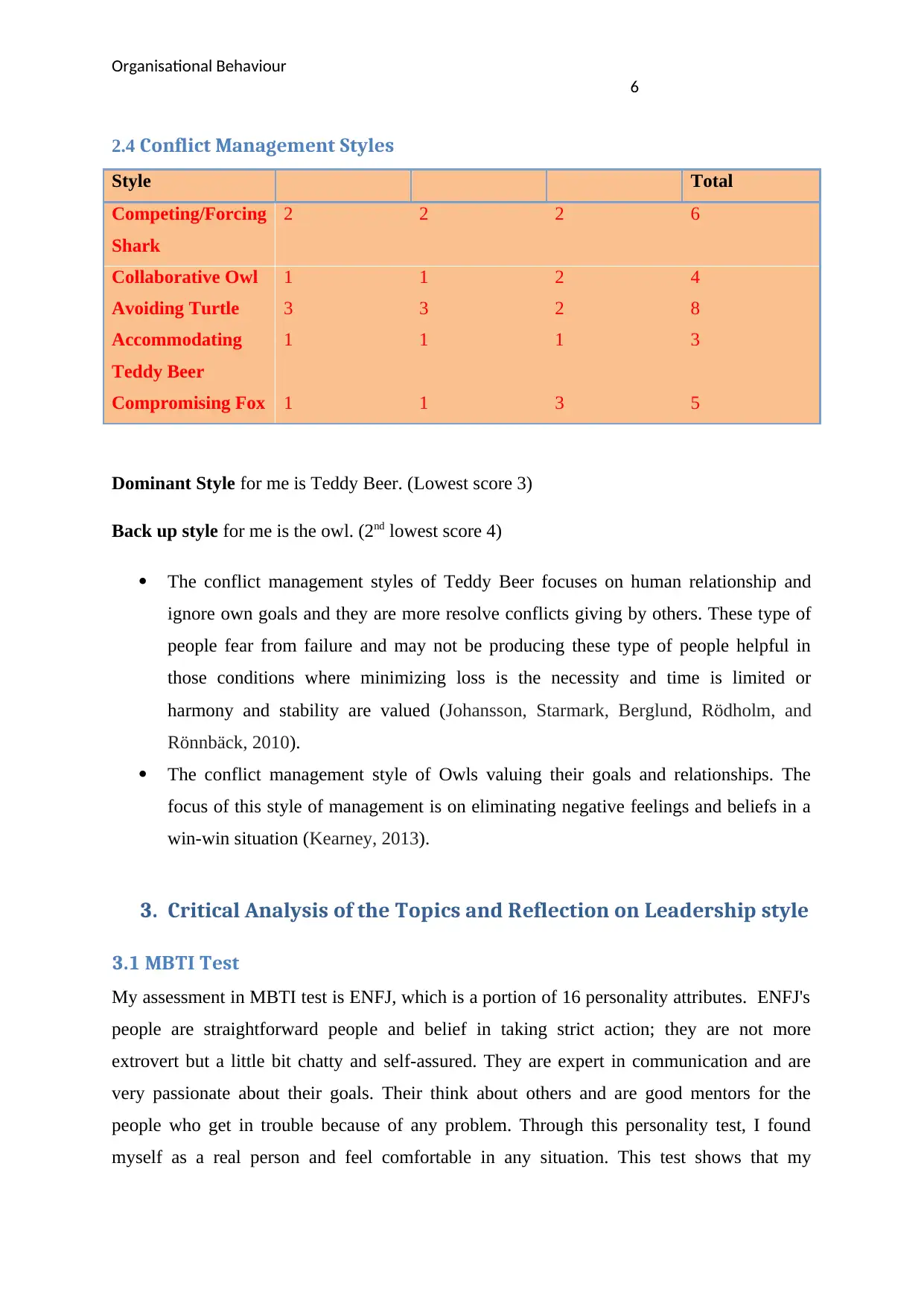
Organisational Behaviour
6
2.4 Conflict Management Styles
Style Total
Competing/Forcing
Shark
2 2 2 6
Collaborative Owl 1 1 2 4
Avoiding Turtle 3 3 2 8
Accommodating
Teddy Beer
1 1 1 3
Compromising Fox 1 1 3 5
Dominant Style for me is Teddy Beer. (Lowest score 3)
Back up style for me is the owl. (2nd lowest score 4)
The conflict management styles of Teddy Beer focuses on human relationship and
ignore own goals and they are more resolve conflicts giving by others. These type of
people fear from failure and may not be producing these type of people helpful in
those conditions where minimizing loss is the necessity and time is limited or
harmony and stability are valued (Johansson, Starmark, Berglund, Rödholm, and
Rönnbäck, 2010).
The conflict management style of Owls valuing their goals and relationships. The
focus of this style of management is on eliminating negative feelings and beliefs in a
win-win situation (Kearney, 2013).
3. Critical Analysis of the Topics and Reflection on Leadership style
3.1 MBTI Test
My assessment in MBTI test is ENFJ, which is a portion of 16 personality attributes. ENFJ's
people are straightforward people and belief in taking strict action; they are not more
extrovert but a little bit chatty and self-assured. They are expert in communication and are
very passionate about their goals. Their think about others and are good mentors for the
people who get in trouble because of any problem. Through this personality test, I found
myself as a real person and feel comfortable in any situation. This test shows that my
6
2.4 Conflict Management Styles
Style Total
Competing/Forcing
Shark
2 2 2 6
Collaborative Owl 1 1 2 4
Avoiding Turtle 3 3 2 8
Accommodating
Teddy Beer
1 1 1 3
Compromising Fox 1 1 3 5
Dominant Style for me is Teddy Beer. (Lowest score 3)
Back up style for me is the owl. (2nd lowest score 4)
The conflict management styles of Teddy Beer focuses on human relationship and
ignore own goals and they are more resolve conflicts giving by others. These type of
people fear from failure and may not be producing these type of people helpful in
those conditions where minimizing loss is the necessity and time is limited or
harmony and stability are valued (Johansson, Starmark, Berglund, Rödholm, and
Rönnbäck, 2010).
The conflict management style of Owls valuing their goals and relationships. The
focus of this style of management is on eliminating negative feelings and beliefs in a
win-win situation (Kearney, 2013).
3. Critical Analysis of the Topics and Reflection on Leadership style
3.1 MBTI Test
My assessment in MBTI test is ENFJ, which is a portion of 16 personality attributes. ENFJ's
people are straightforward people and belief in taking strict action; they are not more
extrovert but a little bit chatty and self-assured. They are expert in communication and are
very passionate about their goals. Their think about others and are good mentors for the
people who get in trouble because of any problem. Through this personality test, I found
myself as a real person and feel comfortable in any situation. This test shows that my
Paraphrase This Document
Need a fresh take? Get an instant paraphrase of this document with our AI Paraphraser
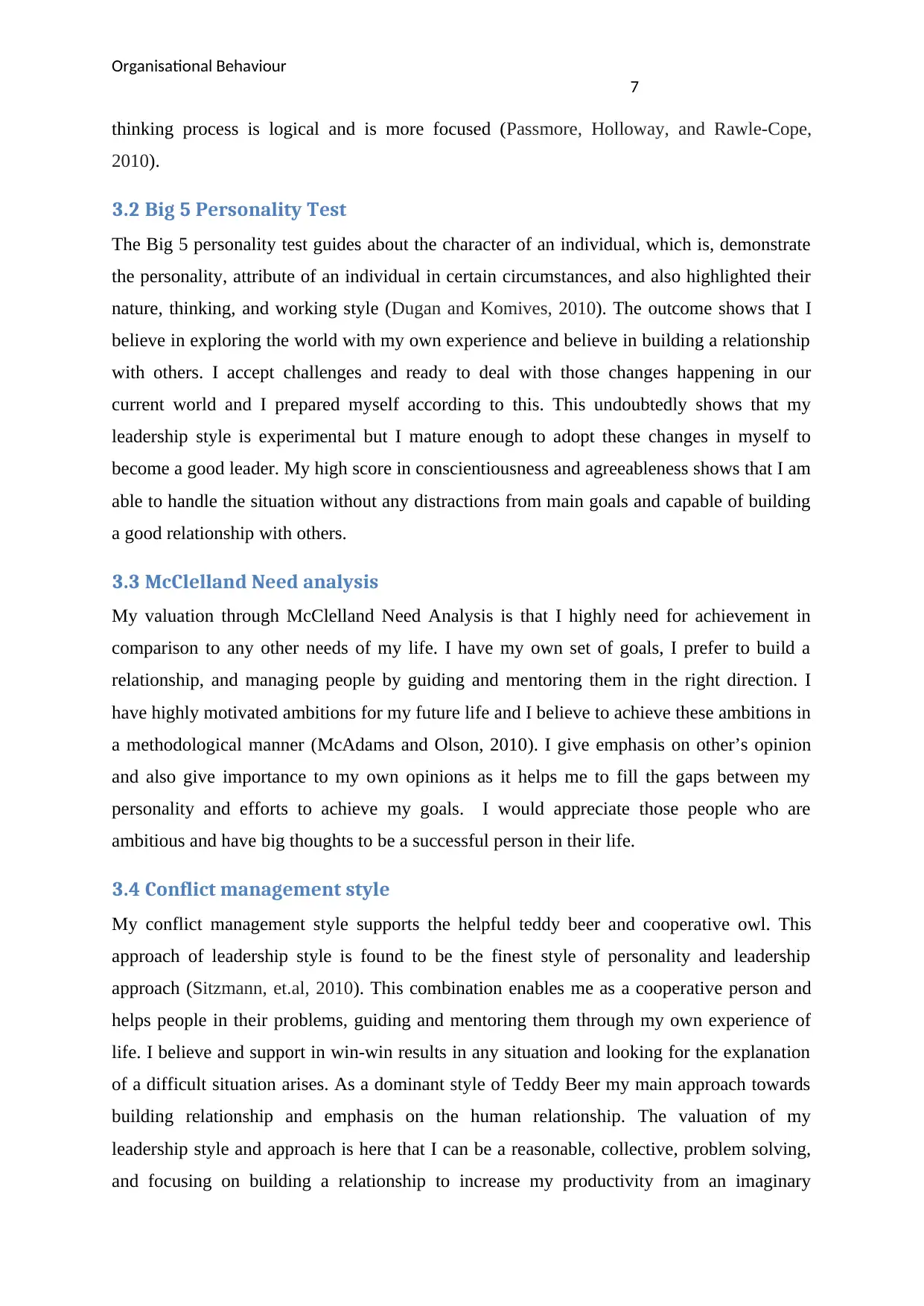
Organisational Behaviour
7
thinking process is logical and is more focused (Passmore, Holloway, and Rawle-Cope,
2010).
3.2 Big 5 Personality Test
The Big 5 personality test guides about the character of an individual, which is, demonstrate
the personality, attribute of an individual in certain circumstances, and also highlighted their
nature, thinking, and working style (Dugan and Komives, 2010). The outcome shows that I
believe in exploring the world with my own experience and believe in building a relationship
with others. I accept challenges and ready to deal with those changes happening in our
current world and I prepared myself according to this. This undoubtedly shows that my
leadership style is experimental but I mature enough to adopt these changes in myself to
become a good leader. My high score in conscientiousness and agreeableness shows that I am
able to handle the situation without any distractions from main goals and capable of building
a good relationship with others.
3.3 McClelland Need analysis
My valuation through McClelland Need Analysis is that I highly need for achievement in
comparison to any other needs of my life. I have my own set of goals, I prefer to build a
relationship, and managing people by guiding and mentoring them in the right direction. I
have highly motivated ambitions for my future life and I believe to achieve these ambitions in
a methodological manner (McAdams and Olson, 2010). I give emphasis on other’s opinion
and also give importance to my own opinions as it helps me to fill the gaps between my
personality and efforts to achieve my goals. I would appreciate those people who are
ambitious and have big thoughts to be a successful person in their life.
3.4 Conflict management style
My conflict management style supports the helpful teddy beer and cooperative owl. This
approach of leadership style is found to be the finest style of personality and leadership
approach (Sitzmann, et.al, 2010). This combination enables me as a cooperative person and
helps people in their problems, guiding and mentoring them through my own experience of
life. I believe and support in win-win results in any situation and looking for the explanation
of a difficult situation arises. As a dominant style of Teddy Beer my main approach towards
building relationship and emphasis on the human relationship. The valuation of my
leadership style and approach is here that I can be a reasonable, collective, problem solving,
and focusing on building a relationship to increase my productivity from an imaginary
7
thinking process is logical and is more focused (Passmore, Holloway, and Rawle-Cope,
2010).
3.2 Big 5 Personality Test
The Big 5 personality test guides about the character of an individual, which is, demonstrate
the personality, attribute of an individual in certain circumstances, and also highlighted their
nature, thinking, and working style (Dugan and Komives, 2010). The outcome shows that I
believe in exploring the world with my own experience and believe in building a relationship
with others. I accept challenges and ready to deal with those changes happening in our
current world and I prepared myself according to this. This undoubtedly shows that my
leadership style is experimental but I mature enough to adopt these changes in myself to
become a good leader. My high score in conscientiousness and agreeableness shows that I am
able to handle the situation without any distractions from main goals and capable of building
a good relationship with others.
3.3 McClelland Need analysis
My valuation through McClelland Need Analysis is that I highly need for achievement in
comparison to any other needs of my life. I have my own set of goals, I prefer to build a
relationship, and managing people by guiding and mentoring them in the right direction. I
have highly motivated ambitions for my future life and I believe to achieve these ambitions in
a methodological manner (McAdams and Olson, 2010). I give emphasis on other’s opinion
and also give importance to my own opinions as it helps me to fill the gaps between my
personality and efforts to achieve my goals. I would appreciate those people who are
ambitious and have big thoughts to be a successful person in their life.
3.4 Conflict management style
My conflict management style supports the helpful teddy beer and cooperative owl. This
approach of leadership style is found to be the finest style of personality and leadership
approach (Sitzmann, et.al, 2010). This combination enables me as a cooperative person and
helps people in their problems, guiding and mentoring them through my own experience of
life. I believe and support in win-win results in any situation and looking for the explanation
of a difficult situation arises. As a dominant style of Teddy Beer my main approach towards
building relationship and emphasis on the human relationship. The valuation of my
leadership style and approach is here that I can be a reasonable, collective, problem solving,
and focusing on building a relationship to increase my productivity from an imaginary

Organisational Behaviour
8
situation (Lu and Hsiao, 2010). If I have to negotiate or compromise, I would prefer other’s
interest above my own interest, which is very important for a leader to support their people
and mentor them.
4. Action plan
What How Result Time period
I have to work on my
negotiation skills and
should give priority
to our own goals.
My personality says
that I am logical and
thinking about the
results and
consequences. That
helps me to
understand the
priority of goals.
The significance of
the approach will
result in appreciable
teamwork and
optimistic vigour in
the organization.
6-9 months
I should try to give
responsibilities to
others of their own
work and should not
involve myself in any
conflict.
I should prepare a
schedule for my own
works and I should
try to focus my own
life-oriented goals by
keeping the study
timetable in my mind
This will support me
to be a good manager
in my future.
6-9 months
5. Conclusion
Self-evaluation is the vital element to be a good leader in the future and which helps a leader
to know his/her inner skills to motivate, guide, and protect others. Valuation of one’s own
personality helps in focusing on own weakness and strengths which can be improved to make
benefit for one and will help in eliminating weakness. Overall, I am a logical and intelligent
person who believes in building the relationship and give emphasis to others over my own
8
situation (Lu and Hsiao, 2010). If I have to negotiate or compromise, I would prefer other’s
interest above my own interest, which is very important for a leader to support their people
and mentor them.
4. Action plan
What How Result Time period
I have to work on my
negotiation skills and
should give priority
to our own goals.
My personality says
that I am logical and
thinking about the
results and
consequences. That
helps me to
understand the
priority of goals.
The significance of
the approach will
result in appreciable
teamwork and
optimistic vigour in
the organization.
6-9 months
I should try to give
responsibilities to
others of their own
work and should not
involve myself in any
conflict.
I should prepare a
schedule for my own
works and I should
try to focus my own
life-oriented goals by
keeping the study
timetable in my mind
This will support me
to be a good manager
in my future.
6-9 months
5. Conclusion
Self-evaluation is the vital element to be a good leader in the future and which helps a leader
to know his/her inner skills to motivate, guide, and protect others. Valuation of one’s own
personality helps in focusing on own weakness and strengths which can be improved to make
benefit for one and will help in eliminating weakness. Overall, I am a logical and intelligent
person who believes in building the relationship and give emphasis to others over my own
⊘ This is a preview!⊘
Do you want full access?
Subscribe today to unlock all pages.

Trusted by 1+ million students worldwide
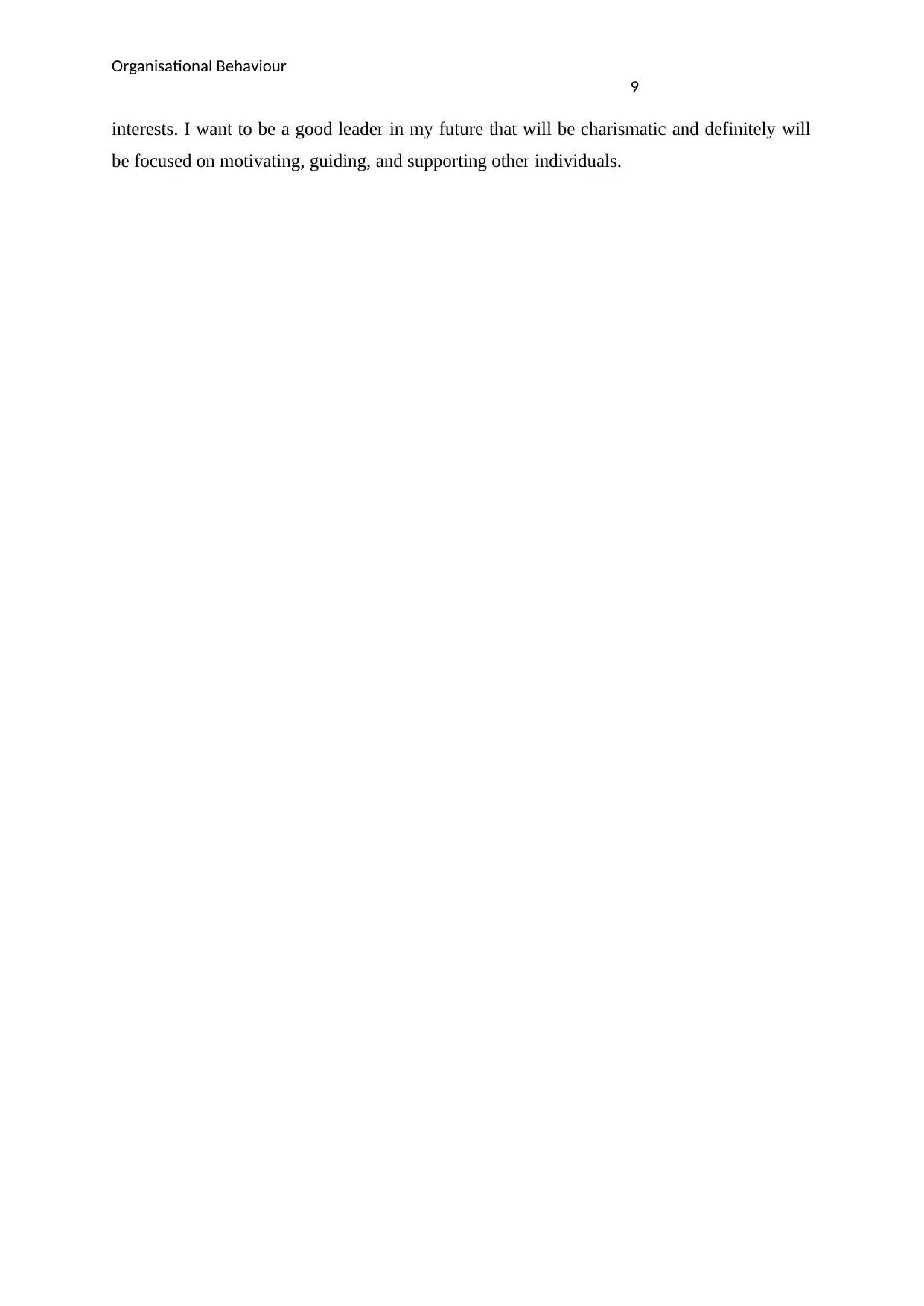
Organisational Behaviour
9
interests. I want to be a good leader in my future that will be charismatic and definitely will
be focused on motivating, guiding, and supporting other individuals.
9
interests. I want to be a good leader in my future that will be charismatic and definitely will
be focused on motivating, guiding, and supporting other individuals.
Paraphrase This Document
Need a fresh take? Get an instant paraphrase of this document with our AI Paraphraser
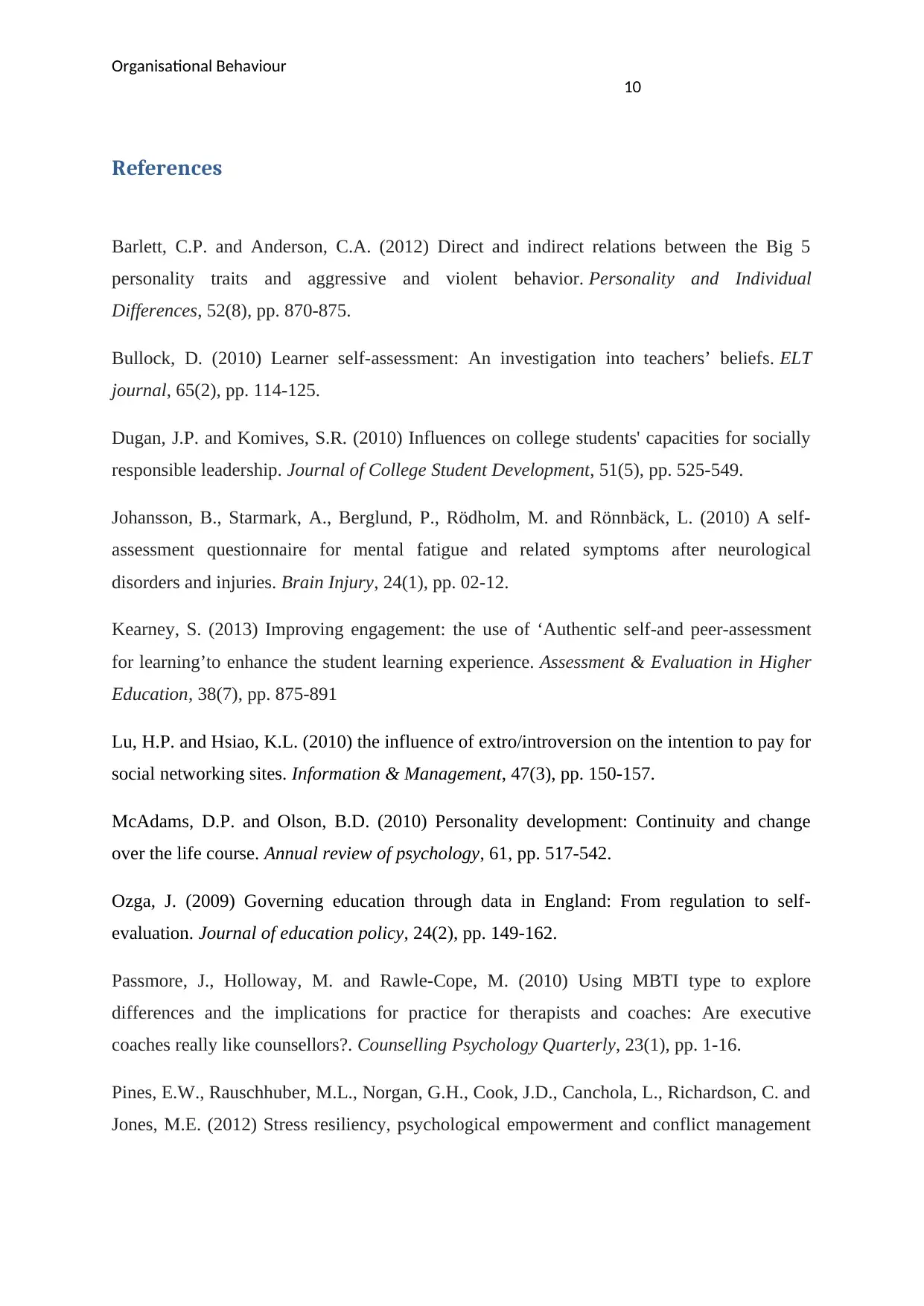
Organisational Behaviour
10
References
Barlett, C.P. and Anderson, C.A. (2012) Direct and indirect relations between the Big 5
personality traits and aggressive and violent behavior. Personality and Individual
Differences, 52(8), pp. 870-875.
Bullock, D. (2010) Learner self-assessment: An investigation into teachers’ beliefs. ELT
journal, 65(2), pp. 114-125.
Dugan, J.P. and Komives, S.R. (2010) Influences on college students' capacities for socially
responsible leadership. Journal of College Student Development, 51(5), pp. 525-549.
Johansson, B., Starmark, A., Berglund, P., Rödholm, M. and Rönnbäck, L. (2010) A self-
assessment questionnaire for mental fatigue and related symptoms after neurological
disorders and injuries. Brain Injury, 24(1), pp. 02-12.
Kearney, S. (2013) Improving engagement: the use of ‘Authentic self-and peer-assessment
for learning’to enhance the student learning experience. Assessment & Evaluation in Higher
Education, 38(7), pp. 875-891
Lu, H.P. and Hsiao, K.L. (2010) the influence of extro/introversion on the intention to pay for
social networking sites. Information & Management, 47(3), pp. 150-157.
McAdams, D.P. and Olson, B.D. (2010) Personality development: Continuity and change
over the life course. Annual review of psychology, 61, pp. 517-542.
Ozga, J. (2009) Governing education through data in England: From regulation to self‐
evaluation. Journal of education policy, 24(2), pp. 149-162.
Passmore, J., Holloway, M. and Rawle-Cope, M. (2010) Using MBTI type to explore
differences and the implications for practice for therapists and coaches: Are executive
coaches really like counsellors?. Counselling Psychology Quarterly, 23(1), pp. 1-16.
Pines, E.W., Rauschhuber, M.L., Norgan, G.H., Cook, J.D., Canchola, L., Richardson, C. and
Jones, M.E. (2012) Stress resiliency, psychological empowerment and conflict management
10
References
Barlett, C.P. and Anderson, C.A. (2012) Direct and indirect relations between the Big 5
personality traits and aggressive and violent behavior. Personality and Individual
Differences, 52(8), pp. 870-875.
Bullock, D. (2010) Learner self-assessment: An investigation into teachers’ beliefs. ELT
journal, 65(2), pp. 114-125.
Dugan, J.P. and Komives, S.R. (2010) Influences on college students' capacities for socially
responsible leadership. Journal of College Student Development, 51(5), pp. 525-549.
Johansson, B., Starmark, A., Berglund, P., Rödholm, M. and Rönnbäck, L. (2010) A self-
assessment questionnaire for mental fatigue and related symptoms after neurological
disorders and injuries. Brain Injury, 24(1), pp. 02-12.
Kearney, S. (2013) Improving engagement: the use of ‘Authentic self-and peer-assessment
for learning’to enhance the student learning experience. Assessment & Evaluation in Higher
Education, 38(7), pp. 875-891
Lu, H.P. and Hsiao, K.L. (2010) the influence of extro/introversion on the intention to pay for
social networking sites. Information & Management, 47(3), pp. 150-157.
McAdams, D.P. and Olson, B.D. (2010) Personality development: Continuity and change
over the life course. Annual review of psychology, 61, pp. 517-542.
Ozga, J. (2009) Governing education through data in England: From regulation to self‐
evaluation. Journal of education policy, 24(2), pp. 149-162.
Passmore, J., Holloway, M. and Rawle-Cope, M. (2010) Using MBTI type to explore
differences and the implications for practice for therapists and coaches: Are executive
coaches really like counsellors?. Counselling Psychology Quarterly, 23(1), pp. 1-16.
Pines, E.W., Rauschhuber, M.L., Norgan, G.H., Cook, J.D., Canchola, L., Richardson, C. and
Jones, M.E. (2012) Stress resiliency, psychological empowerment and conflict management
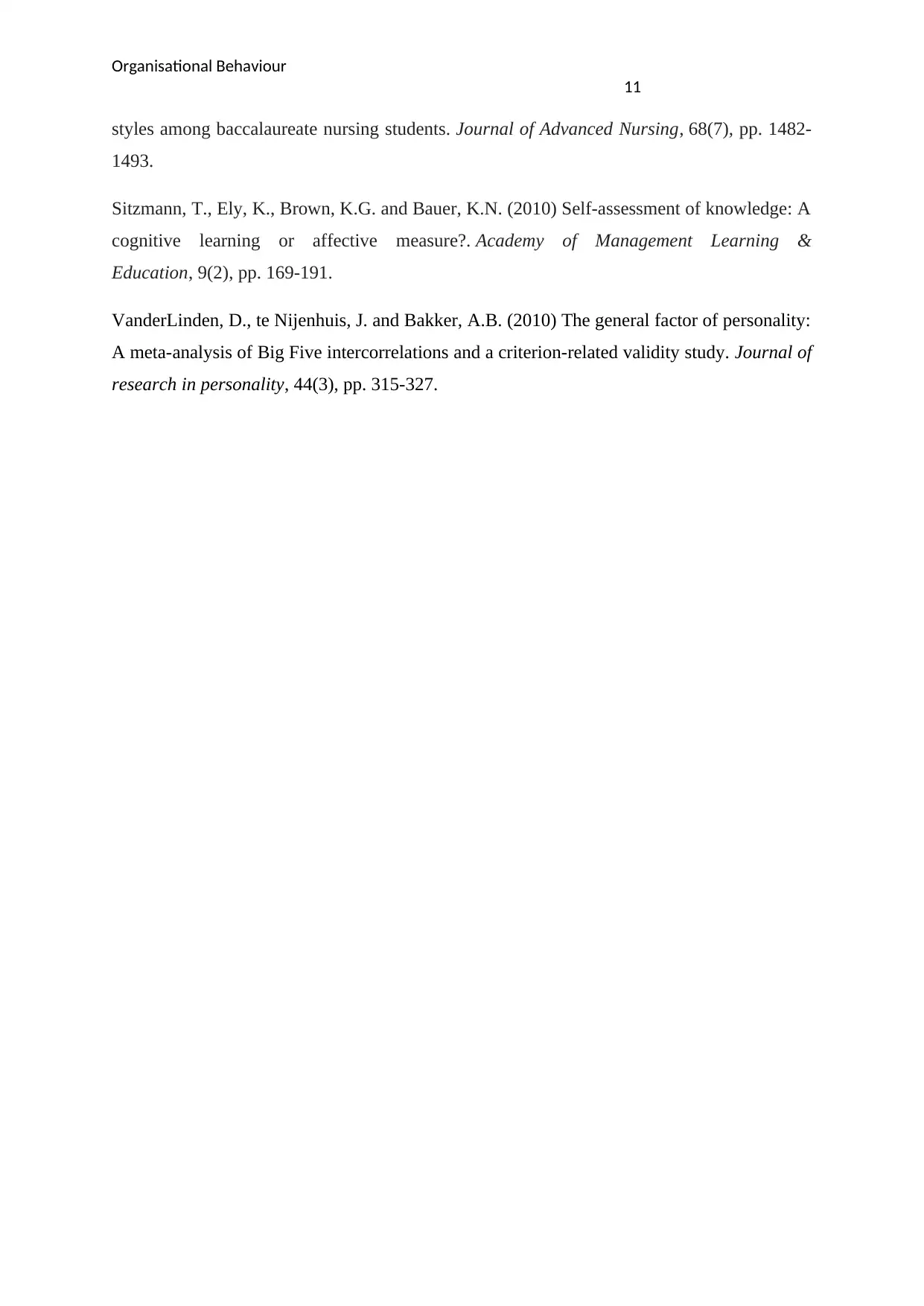
Organisational Behaviour
11
styles among baccalaureate nursing students. Journal of Advanced Nursing, 68(7), pp. 1482-
1493.
Sitzmann, T., Ely, K., Brown, K.G. and Bauer, K.N. (2010) Self-assessment of knowledge: A
cognitive learning or affective measure?. Academy of Management Learning &
Education, 9(2), pp. 169-191.
VanderLinden, D., te Nijenhuis, J. and Bakker, A.B. (2010) The general factor of personality:
A meta-analysis of Big Five intercorrelations and a criterion-related validity study. Journal of
research in personality, 44(3), pp. 315-327.
11
styles among baccalaureate nursing students. Journal of Advanced Nursing, 68(7), pp. 1482-
1493.
Sitzmann, T., Ely, K., Brown, K.G. and Bauer, K.N. (2010) Self-assessment of knowledge: A
cognitive learning or affective measure?. Academy of Management Learning &
Education, 9(2), pp. 169-191.
VanderLinden, D., te Nijenhuis, J. and Bakker, A.B. (2010) The general factor of personality:
A meta-analysis of Big Five intercorrelations and a criterion-related validity study. Journal of
research in personality, 44(3), pp. 315-327.
⊘ This is a preview!⊘
Do you want full access?
Subscribe today to unlock all pages.

Trusted by 1+ million students worldwide
1 out of 12
Related Documents
Your All-in-One AI-Powered Toolkit for Academic Success.
+13062052269
info@desklib.com
Available 24*7 on WhatsApp / Email
![[object Object]](/_next/static/media/star-bottom.7253800d.svg)
Unlock your academic potential
Copyright © 2020–2025 A2Z Services. All Rights Reserved. Developed and managed by ZUCOL.





